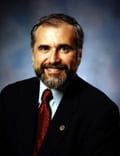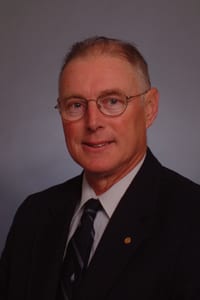WHOI Director, Scientist Elected Fellows of American Academy of Arts and Sciences
May 22, 2002
Woods Hole Oceanographic Institution (WHOI) Director and President Robert Gagosian and Senior Scientist John Whitehead of the Physical Oceanography Department were recently elected Fellows of the American Academy of Arts and Sciences, one of the oldest learned societies in the nation. Drs. Gagosian and Whitehead are among the 177 Fellows and 30 Foreign Honorary Members elected to the 2002 Class, which includes a United States Senator and a Representative, four college presidents, three Nobel Prize winners, six Pulitzer Prize winners, three MacArthur Fellows and six Guggenheim Fellows.
Dr. Gagosian was elected to the Educational, Scientific, Cultural and Philanthropic Administration (non-profit) section, while Dr. Whitehead was elected to the Astronomy and Earth Sciences section. Others elected Fellows include US Senator Edward Kennedy of Massachusetts, violinist Itzhak Perlman, Academy Award winner Angelica Huston, and Nobel laureate George Olah.
Dr. Gagosian has been Director of the Woods Hole Oceanographic Institution since 1994 and was named President in 2001. He received his B.S degree in chemistry from the Massachusetts Institute of Technology in 1966 and his Ph.d degree in organic chemistry from Columbia University in 1970. He was a National Institutes of Health Post-doctoral Fellow from 1970 to 1972 at the University of California at Berkeley before joining the WHOI staff in 1972 as an assistant scientist. He was promoted to Associate Scientist in 1976 and to Senior Scientist in 1982. Dr. Gagosian served as chair of the Chemistry Department from 1982 to 1987, when he assumed the position of Associate Director for Research at the Institution. He then served as Senior Associate Director and Director of Research from 1992 to 1993, and was Acting Director from August to December 1993 before being named Director in January 1994 and President in 2001. He is the recipient of Honorary Doctor of Science Degrees from Southampton College of Long Island University and Northeastern University, both awarded in 2000.
“I am very pleased and honored,” Gagosian said of the news. A marine geochemist for many years before assuming administrative responsibilities, he has participated in fourteen oceanographic cruises, including seven as Chief Scientist, and four major field programs. His award citation notes his “contributions to our understanding of the cycling and nature of organic materials in the ocean and his research on biologically produced organic compounds, with emphasis on the transport processes and transformation reactions of organic material as it travels from land to sea.”
Dr. Whitehead has worked at WHOI since 1971. He received his B.S degree in mechanical engineering from Tufts University in 1963, and his M.S. and Ph.D. degrees from Yale University in 1965 and 1968, respectively, in Engineering/Applied Science. He worked as a research geophysicist at the Institute of Geophysics and Planetary Physics at the University of California at Los Angeles (UCLA) from 1968 to 1971, when he joined the Woods Hole Oceanographic Institution staff as an assistant scientist. He was promoted to Associate Scientist in 1973, and was named a Senior Scientist in 1988. He is the current, and first, recipient of the Institution’s Paul Fye Chair, established in 1997. His research interests focus on the physics of continuous media and laboratory and theoretical modeling of geophysical flows, especially buoyancy-driven flows in the ocean and in the earth.
“It was quite a surprise,” Whitehead said of his election. His award citation calls him “an experimentalist who has made fundamental contributions in many areas of geophysical fluid dynamics. His experimental work on convection led the way in understanding the nonlinear character of stability theory for thermal convection. He has done fundamental experimental work on the dynamics of flows in volcanic conduits in the earth’s mantle, in deep, hydraulically controlled oceanic flows in straits connected to ocean basics, and on multiple equilibria in fluid systems pertinent to the oceanic thermohaline circulation.” Jack Whitehead has been active in the Institution’s Geophysical Fluid Dynamics Summer Study program for 30 years, and is a Guggenheim Fellow, a Fellow of the American Physical Society, and a Fellow of the American Geophysical Union.
“The Academy is pleased to welcome these outstanding and influential individuals to the nation’s most illustrious learned society. Election to the American Academy is the result of a highly competitive process that recognizes those who have made preeminent contributions to all scholarly fields and professions,” said Academy President Patricia Meyer Spacks. Leslie C. Berlowitz, the Academy’s Executive Officer, added, “The American Academy is unique among America’s academies for its breadth and scope. Throughout its history, the Academy has gathered individuals with diverse perspectives to participate in studies and projects focusing on advancing intellectual thought and constructive action in American society.” The selection of Foreign Honorary members continues the tradition of honoring distinguished experts and intellectuals from outside the United States whose work complements the values of the American Academy. Niels Bohr, Alfred, Lord Tennyson, Jawaharlal Nehru, and Albert Camus were among past elected Foreign Honorary Members. This year’s class include novelist Milan Kundera; Nobel Prize winning author Kenzaburo Oe; Lord Anthony P. Lester, president of the International Centre for the Legal Protection of Human Rights; and Fritz W. Scharpf, director of the Max Planck Institute for the Study of Societies. The 2002 class includes 177 Fellows and 30 Foreign Honorary Members.
The selection of Foreign Honorary members continues the tradition of honoring distinguished experts and intellectuals from outside the United States whose work complements the values of the American Academy. Niels Bohr, Alfred, Lord Tennyson, Jawaharlal Nehru, and Albert Camus were among past elected Foreign Honorary Members. This year’s class include novelist Milan Kundera; Nobel Prize winning author Kenzaburo Oe; Lord Anthony P. Lester, president of the International Centre for the Legal Protection of Human Rights; and Fritz W. Scharpf, director of the Max Planck Institute for the Study of Societies. The 2002 class includes 177 Fellows and 30 Foreign Honorary Members.
New Fellows and Foreign Honorary Members are nominated and elected by current members of the Academy. Members are divided into five distinct classes: I) mathematics and physics; II) biological sciences; III) social sciences; IV) humanities and arts; and V) public affairs and business. The unique structure of the American Academy allows Members to conduct interdisciplinary studies that draw on the range of academic and intellectual disciplines
The Academy was founded in 1780 by John Adams, James Bowdoin, John Hancock and other scholar-patriots “to cultivate every art and science which may tend to advance the interest, honor, dignity, and happiness of a free, independent, and virtuous people.” According to the Academy’s announcement, it has elected as Fellows and Foreign Honorary Members “the finest minds and most influential leaders from each generation, including George Washington and Ben Franklin in the eighteenth century, Daniel Webster and Ralph Waldo Emerson in the nineteenth, and Albert Einstein and Winston Churchill in the twentieth. The current membership includes more than 150 Nobel laureates and 50 Pulitzer Prize winners. Drawing on the wide-ranging expertise of its membership, the American Academy conducts thoughtful, innovative, non-partisan studies on international security, social policy, education, and the humanities.”
The Academy will welcome this year’s new Fellows and Foreign Honorary Members at the annual Induction Ceremony at the Academy’s headquarters in Cambridge, Massachusetts on October 5, 2002. A full list of new Members is available on the Academy website at https://www.amacad.org/directory.


